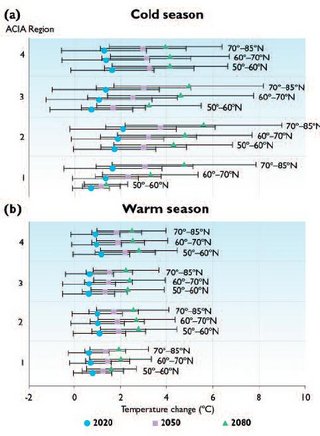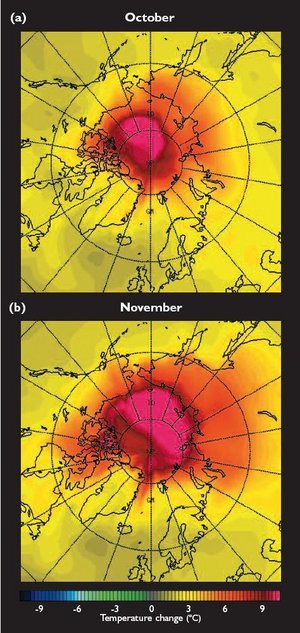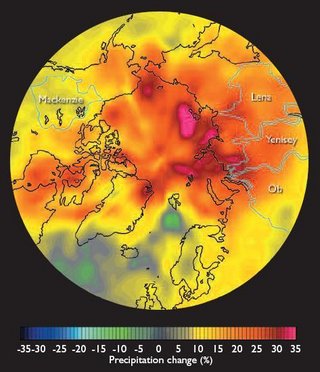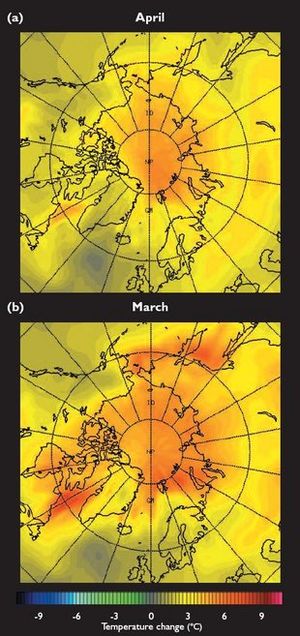Broad-scale effects of climate change on freshwater systems in the Arctic
This is Section 8.4.1 of the Arctic Climate Impact Assessment
Lead Authors: Frederick J.Wrona,Terry D. Prowse, James D. Reist; Contributing Authors: Richard Beamish, John J. Gibson, John Hobbie, Erik Jeppesen, Jackie King, Guenter Koeck, Atte Korhola, Lucie Lévesque, Robie Macdonald, Michael Power,Vladimir Skvortsov,Warwick Vincent; Consulting Authors: Robert Clark, Brian Dempson, David Lean, Hannu Lehtonen, Sofia Perin, Richard Pienitz, Milla Rautio, John Smol, Ross Tallman, Alexander Zhulidov
Arctic freshwater systems are particularly sensitive to climate change because numerous hydro-ecological processes respond to even small changes in climate. These processes may adjust gradually to changes in climate, or abruptly as environmental or ecosystem thresholds are exceeded (Box 8.2). This is especially the case for cryospheric components that significantly affect the water cycle of lakes, rivers, and ponds; the habitat characteristics of these freshwater systems; and the flora and fauna that occupy them. In the case of large arctic rivers (e.g., the Lena, Mackenzie, Ob, and Yenisey), the effects of climate change must be evaluated for areas outside of as well as within the Arctic. The dynamics of such large systems depend on hydrologic processes prevailing within their water-rich headwaters in more temperate southern latitudes. In addition, many of these headwater areas are regulated in some way, a factor that may interact in some way with downstream arctic climate change impacts.
|
Box 8.2.Thresholds of response: step changes in freshwater systems induced by climate change Some climate change effects projected for arctic freshwaters are likely to result in small, slow responses in the environment; other changes are likely to exceed environmental or ecosystem thresholds and cause a dramatic switch in organisms or a change of state of the system.Thresholds may be physical (e.g., permafrost is likely to begin to slowly thaw when the mean annual air temperature approaches 0 ºC); chemical (e.g., the bottom waters of a lake are likely to lose all oxygen when lake productivity increases or allochthonous carbon increases); or biological (e.g., insect larvae frozen in the bottom of tundra ponds will die when their temperature falls below -18 ºC; Scholander et al., 1953). While thresholds are only a part of the whole picture of response, they are critical to the understanding and assessment of the full scope of climate change impacts. One obvious physical threshold is the amount of heat necessary to melt the ice cover of a lake. At the northern limit of the terrestrial Arctic, such as on Ellesmere Island, there are lakes that have only recently begun to have open water during the summer; other lakes now have open water for more summers every decade than in the past. Sediment records of algae, in particular diatom species and chrysophyte abundance, show that in Finland and northern Canada, lakes were ice-bound for thousands of years but conditions began to change about 150 years ago. With open water, the algal community shifts from a predominance of benthic diatoms to planktonic forms, and chrysophytes begin to occur. This is the result of an increase in summer air temperatures caused by climate change and the earlier onset of melt. Some scientists believe that the likely increase in growing-season length may also be important in controlling algal species. Shifts in species composition at the level of primary producers are also likely to have consequences for higher trophic levels through the alteration of food pathways.This could possibly lead to local extirpation of benthic and planktonic animals, as well as overall shifts in productivity. Another physical threshold is the onset of stratification in lakes. Once lakes begin to have open water, wind-driven water circulation becomes one of the controls of biological processes. Almost all lakes have a period of complete mixing of the water column immediately after the ice cover disappears.Very cold waters may continue to circulate for the entire summer so that each day algae spend a significant amount of time in deep waters where there is not enough light for growth. When a lake stratifies (i.e., when only the uppermost waters mix), algae have better light conditions and primary production increases.The higher temperatures in the upper waters increase the rates of all biotic processes. There is a threshold, probably tied to increased primary production, when entirely new trophic levels appear. For example, the sediment record from a lake in Finland shows that Cladocera, a type of zooplankton, began to appear around 150 years ago. Most lakes in the Arctic already exhibit summer stratification, so this threshold will apply mostly to lakes in the far north. When air temperatures increase above a mean annual air temperature of -2 ºC, permafrost begins to thaw. When the upper layers of ice-rich permafrost thaw, the soil is disturbed; lakes may drain, and ponds form in depressions. In eastern Siberia, newly thawed soils that are rich in organic matter slump into lakes. Microbial action depletes the oxygen in the lake allowing the bacteria to produce so much methane that the lakes and ponds become a significant source of this greenhouse gas, and enhance an important feedback to the climate system.This threshold is likely to affect lakes in the more southerly regions of the Arctic. It is well known that lakes surrounded by shrubs and trees contain much more colored dissolved organic matter (CDOM; see Section 8.6.1, Box 8.10 (Broad-scale effects of climate change on freshwater systems in the Arctic)) than lakes in the tundra zone.The CDOM comes from the organic matter produced by plants and modified by soil microbes. It strongly absorbs light, such that the algae of the upper waters become light limited and primary production is reduced.This may also be accompanied by a shift towards increasing primary production by attached algae in the shallow inshore zone relative to offshore planktonic production. The threshold described here is related to the treeline, often demarcated by patches rather than a continuous zone of vegetation. As air temperatures increase over the 21st century these patches are likely to expand, fuse, and move further north, resulting in a slowly moving band of affected lakes. Extreme polar-desert catchments in the high Arctic are very likely to experience their first arrival of higher plants, and a sudden increase in the transfer of organic materials from land to water. As lakes warm, some species or populations of species will probably reach a temperature threshold for survival. This threshold is linked to increases in the rate of metabolism and growth. For example, a bioenergetic model based on laboratory studies projects that the young-of-the-year lake trout in northern Alaska will not obtain enough food for growth if their metabolic rate rises in response to a temperature increase of a degree or so. Evidence from field studies of a stream fish, the Arctic grayling (Thymallus arcticus), also suggests that a population at the northern limit of its distribution is unlikely to survive an increase of only a few degrees in summer water temperatures. Both these examples are of fish species at the northern limit of their distribution. Other types of widely distributed fish, such as whitefish and Arctic char, are less likely to be affected unless new competing species arrive from southerly regions. A different type of threshold involves a shift in the ecological behavior of migratory fish such as the Arctic char. In many arctic rivers, char migrate to the sea for some months every year; the productive marine food web allows them to grow to a large size. Local fishers harvest many of these sea-run fish in the rivers each time the fish congregate and migrate. When freshwaters become more productive, migrations to the sea are projected to decrease and may eventually cease, thus the char are likely to remain in freshwater rivers and lakes for the entire year. These freshwaters are much less productive than the marine ecosystems; therefore, adult freshwater char are likely to be much smaller than are migrating char. As a result of climate change, a valuable food resource for arctic peoples is likely to change with respect to sizes available, and could possibly be lost. |
Prior to considering the specific effects of climate change on arctic freshwater systems, it is useful to place the climate projections generated by the five Arctic Climate Impact Assessment (ACIA) designated atmosphere–ocean general circulation models (AOGCMs) for the Arctic as a whole into a more suitable freshwater context. For the most part, this requires focusing on model projections for the major arctic terrestrial landscapes, including some extra-arctic headwater areas, since these are the domains of freshwater systems. The following paragraphs review the ACIA-designated model projections (primarily for the final time slice, 2071–2090, to illustrate the most pronounced changes) and, through additional processing of the model projections, provide a perspective on how such changes may be important to broad-scale features of arctic freshwater ecosystems, and a background template for the subsequent discussions of specific effects.
For the area north of 60° N, the five ACIA-designated models project that the mean annual temperature will increase by 3.7°C (five-model average) between the 1981–2000 baseline and the 2071–2090 time slice, or approximately twice the projected increase in global mean annual temperature (Section 4.4.2 (Broad-scale effects of climate change on freshwater systems in the Arctic)). At a global scale, AOGCMs used in the Third Assessment Report of the Intergovernmental Panel on Climate Change[1] project that it is very likely that nearly all land areas, which include freshwater systems, will warm more rapidly than the global average, particularly during the cold season at northern high latitudes. Within the Arctic, the spatial distribution of the projected temperature increases in terrestrial areas is associated with even greater projected temperature increases over the central Arctic Ocean. For example, the five-model average projects that autumn (October–December) temperatures over large areas of the Arctic Ocean will increase by up to 9°C by 2071–2090 compared to the 1981–2000 baseline ([[Section 4.4.2 (Broad-scale effects of climate change on freshwater systems in the Arctic)]2]). Adjacent to the Arctic Ocean, the models project substantial temperature increases for extensive terrestrial areas, with the largest projected temperature increases closest to the coastal margins and decreasing to the south.
This pattern of temperature increases is likely to have serious implications for high-latitude coastal areas such as the Russian polar desert and northern tundra, where temperature and associated species distribution gradients are steep (e.g., vascular species abundance increases five-fold from north to south on the Taymir Peninsula; see Section 7.3.1.1 (Broad-scale effects of climate change on freshwater systems in the Arctic)). Figure 8.9a shows the spatial pattern of October warming projected for the 2071–2090 time slice. (Note the spatial congruence of warming between the ocean and the adjacent arctic coastal zone and the extension to more southerly latitudes.) Areas where projected temperature increases are particularly pronounced include northern Siberia and the western portions of the Canadian Archipelago. Notably, however, the maximum projected air temperature increases in these areas are about 5°C (greatest near the coasts), compared to the almost two-fold greater projected increases in temperature over the Arctic Ocean. Such pronounced potential temperature increases in freshwater systems in October are particularly important because this is typically the time when freshwater lake and river systems along the coastal margins currently experience freeze-up. Employing a typical rate of change for freeze-up of 1 day per 0.2°C increase in temperature[1], the projected temperature increases could cause delays of up to 25 days in freeze-up by 2071– 2090. This is likely to have the greatest effect on higher-latitude, near-coastal freshwater systems (see also Sections 8.4.3.1 (Broad-scale effects of climate change on freshwater systems in the Arctic) and 6.7.3 (Broad-scale effects of climate change on freshwater systems in the Arctic)).
Even more dramatic temperature increases are projected for coastal land areas in November (Fig. 8.9b). Significant temperature increases are projected for most coastal areas in Region 3 and more southerly latitudes in Region 2, including the headwater regions of the major Siberian Arctic rivers below 60° N. Latitudinal gradients of temperature increases are especially important for arctic freshwater systems because of the influence of extra-arctic basins on the timing and magnitude of flow in the major northward-flowing arctic rivers. In the case of Region 2, projected temperature increases in November south of 60° N are significant because this is typically the month that marks the beginning of major snow accumulation. Similar to the delay in freeze-up, such higher temperatures would effectively decrease the length of time available to accumulate a winter snowpack. This would subsequently be reflected in the magnitude of the spring snowmelt that forms the major hydrologic event of the year at northern latitudes and is known to significantly affect downstream arctic river and delta systems. The effect of a reduced period of winter snow accumulation on the freshet magnitude, however, is likely to be offset by the projected increase in winter precipitation. The terrestrial regions of North America and Eurasia are among the areas with the greatest projected precipitation increases; similar to temperature, the largest increases are projected for autumn and winter (Section 4.4.3 (Broad-scale effects of climate change on freshwater systems in the Arctic)). Although caution must be used in interpreting regional trends from the simulated precipitation patterns because of large variations in model projections, the average of the five ACIA-designated model projections also shows winter increases in precipitation for the extra-arctic headwater regions of the large northern rivers (Fig. 8.10). The degree to which this would compensate for the reduced duration of winter snow accumulation, however, requires detailed regional analysis.

Over the terrestrial regions of the northern latitudes, it is the cold season (defined here as October to May, the current period of dominant snow and ice cover for freshwater systems) that is characterized by the steepest latitudinal gradients in projected temperature increases. Figure 8.11 displays the projected changes in average temperature (from the ACIA 1981–2000 baseline) over terrestrial areas for the four ACIA regions broken into three latitudinal bands of 70°–85°, 60°–70°, and 50°– 60° N. The latter represents the zones of higher precipitation that feed the major arctic rivers in Region 2 (Lena, Ob, and Yenisey) and eastern Region 3 plus western Region 4 (Mackenzie River). The steepest latitudinal gradients in projected cold-season temperature increases are evident in Regions 1 and 3, becoming particularly magnified in the latter by 2071–2090, whereas Region 4 shows a slight decrease in the level of warming with latitude. Hence, except for Region 4, it appears that with continued temperature increases the higher-latitude zones will continue to experience the relatively highest degree of warming. This would lead to a reduction in the thermal gradient along the course of some of the major arctic rivers. If such reductions prevail during particular parts of the cold season, they are likely to have major implications for the dynamics of particular hydrologic events such as the spring freshet and ice breakup.
In general, the most severe spring floods on cold-regions rivers are associated with a strong climatic gradient between the headwaters and the downstream reaches – typically from south to north on most large arctic rivers[2]. In such cases, the spring flood wave produced by snowmelt must "push" downstream into colder conditions, and hence towards a relatively competent ice cover that has experienced little thermal decay. Changes in the strength of this climatic gradient would alter the severity of breakup and the associated flooding. Figure 8.12a illustrates the change in average air temperature projected for April 2071–2090. This is currently the month of freshet initiation, with May the primary month of freshet advance, in the southern headwaters of the major arctic rivers. With projected advances in the timing of ice and flow conditions (see also Section 6.7.3 (Broad-scale effects of climate change on freshwater systems in the Arctic)), April should become the primary month of freshet advance by 2071–2090. Of particular note in Fig. 8.12a are the substantial projected temperature increases in the downstream areas of the major Russian rivers. Such high-latitude temperature increases are likely to lead to less severe ice breakups and flooding as the spring flood wave pushes northward. A comparable degree of high-latitude temperature increase is absent for the Mackenzie River. Of additional note in Fig. 8.12 is the degree of warming projected to occur in the headwater regions of the three large Russian rivers during April and March. This is very likely to result in an early onset of snowmelt along these rivers. Again, however, a comparable degree of headwater warming and hence snowmelt runoff is not projected for the Mackenzie Basin. This regional dichotomy is likely to produce future differences in the spring timing of lake- and river-ice breakup and associated freshet, including the ultimate export of freshwater to the Arctic Ocean.
Although the smallest temperature increases are projected for the open-water warm season in all regions and at all latitudes (Fig. 8.11b), even the projected ~1 to 3°C temperature increase is likely to significantly increase evaporative losses from freshwater systems, especially with a shortened ice season, and via evapotranspiration from the terrestrial landscape that feeds them. Similar to changes in winter snowpack, increases in precipitation could offset such temperature-induced evaporative losses, but the five-model average projects that precipitation increases will be smallest during the summer. More detailed consideration of the changes and effects on coldregions hydrology that could result from the changes in climate projected by the ACIA-designated models are provided in subsequent sections and in Chapter 6 (Broad-scale effects of climate change on freshwater systems in the Arctic).
Chapter 8: Freshwater Ecosystems and Fisheries
8.1. Introduction (Broad-scale effects of climate change on freshwater systems in the Arctic)
8.2. Freshwater ecosystems in the Arctic
8.3. Historical changes in freshwater ecosystems
8.4. Climate change effects
8.4.1. Broad-scale effects on freshwater systems
8.4.2. Effects on hydro-ecology of contributing basins
8.4.3. Effects on general hydro-ecology
8.4.4. Changes in aquatic biota and ecosystem structure and function
8.5. Climate change effects on arctic fish, fisheries, and aquatic wildlife
8.5.1. Information required to project responses of arctic fish
8.5.2. Approaches to projecting climate change effects on arctic fish populations
8.5.3. Climate change effects on arctic freshwater fish populations
8.5.4. Effects of climate change on arctic anadromous fish
8.5.5. Impacts on arctic freshwater and anadromous fisheries
8.5.6. Impacts on aquatic birds and mammals
8.6. Ultraviolet radiation effects on freshwater ecosystems
8.7. Global change and contaminants
8.8. Key findings, science gaps, and recommendations
References
- ^ Adams, S. IPCC, 2001b. Climate Change 2001: The Scientific Basis. Contribution of Working Group I to the Third Assessment Report of the Intergovernmental Panel on Climate Change. J.T. Houghton, Y. Ding, D.J. Griggs, M. Noguer, P.J. van der Linden, X. Dai, K. Maskell and C.A. Johnson (eds.). Intergovernmental Panel on Climate Change. Cambridge University Press, 881pp.
Citation
Committee, I. (2012). Broad-scale effects of climate change on freshwater systems in the Arctic. Retrieved from http://editors.eol.org/eoearth/wiki/Broad-scale_effects_of_climate_change_on_freshwater_systems_in_the_Arctic- ↑ Magnuson, J.J., D.M. Robertson, B.J. Benson, R.H. Wynne, D.M. Livingstone, T. Arai, R.A. Assel, R.G. Barry, V. Card, E. Kuusisto, N.G. Granin, T.D. Prowse, K.M. Stewart and V.S.Vuglinski, 2000. Historical trends in lake and river ice cover in the Northern Hemisphere. Science, 289:1743–1746.
- ↑ Gray, D.M. and T.D. Prowse, 1993. Snow and floating ice. In: D.R. Maidment (ed.). Handbook of Hydrology, pp. 7.1–7.58. McGraw-Hill.


